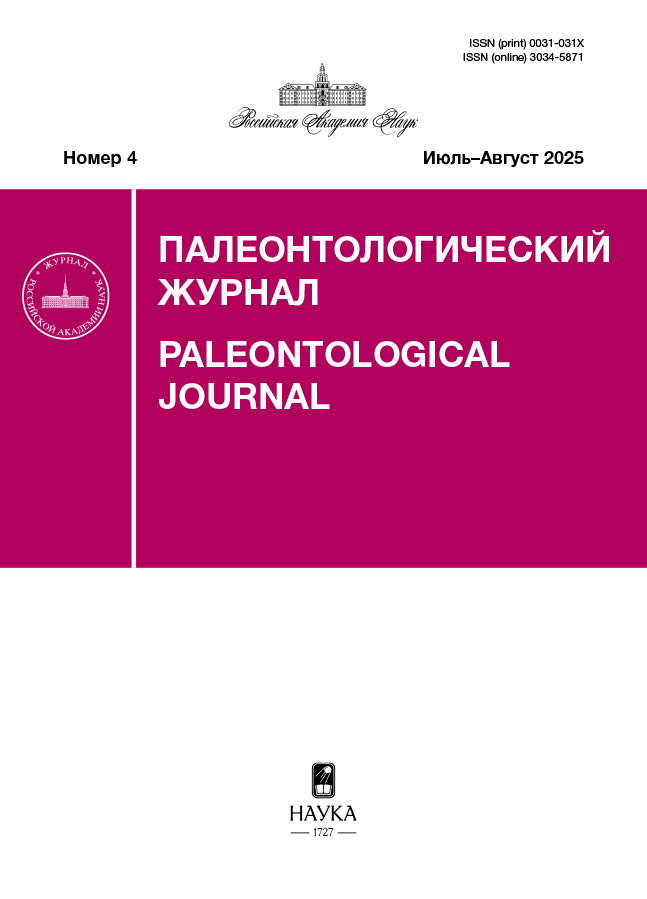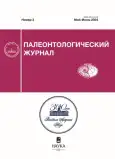№ 3 (2024)
Новые данные по микроструктуре Tannuolina (Кембрийские зоопроблематики)
Аннотация
Проведено морфологическое изучение фосфатных склеритов Tannuolina pavlovi Kouchinsky, Bengtson et Murdock, 2010 из разреза костинской свиты Сибирской платформы (правый берег р. Сухая Тунгуска). Впервые описана микроструктура склеритов, стенка которых имеет двухслойное строение.
 3-9
3-9


Новый вид сфинктозоа (Porifera) Paradeningeria magna sp. nov. из Находкинского рифа (Южное Приморье)
 10-15
10-15


Новый вид рода Lekiskochiton (Mollusca, Polyplacophora) из нижнепермских рифогенных известняков Шахтау (Южное Предуралье)
Аннотация
Древний обитатель раннепермского рифа Шахтау, хитон из отряда Lepidopleuridae, описан как Lekiskochiton crassus sp. nov. Это один из немногих видов палеозойских хитонов, описанных в России, и первый из Предуралья. Новый вид представлен хвостовым и четырьмя промежуточными щитками одной очень крупной особи, обнаруженной в рифогенных карбонатах ассельского яруса. Другие разрозненные щитки были найдены в том же рифогенном массиве в сакмарском ярусе. Все они сохранились в виде отпечатков. Форма щитков частично реконструирована. Впервые показаны морфологические различия промежуточных щитков одной особи этого рода. L. crassus sp. nov. – это второй вид рода Lekiskochiton, который ранее достоверно был известен только по типовому виду из средней перми Техаса. Находка нового вида увеличивает интервал существования рода примерно на 19 млн лет. В комплексе полиплакофор Шахтау, кроме рода Lekiskochiton, предварительно определены такие роды, как Gryphochiton, Ochmazochiton, и Pterochiton, что свидетельствует о биогеографических связях раннепермского Уральского пролива с морскими бассейнами Северной Америки.
 16-27
16-27


Онтогенез раковин цератитов Otoceras concavum Tozer и проблема происхождения отоцератид
Аннотация
В результате детального изучения поперечных сечений наиболее древних (позднепермских) представителей рода Otoceras Griesbach (O. concavum Tozer) из основания некучанской свиты верховьев р. Восточная Хандыга Южного Верхоянья выяснены особенности изменения в онтогенезе формы их раковин. Определены тенденции изменения основных показателей раковины в процессе ее роста, выявлена цикличность сужения и расширения раковины, установлена последовательность изменения формы сечения оборота. Прослежено формирование килей и возникновение трикаринатной формы вентральной стороны. Определение преобразований формы раковины в онтогенезе O. concavum способствует диагностике мелкорослых отоцерасов и может послужить основой для последующей реконструкции морфогенетического развития семейства Otoceratidae. Установленная на средней стадии онтогенеза пентакаринатная форма внешней части оборота может являться признаком, унаследованным от предка – рода Avushoceras Ruzhencev.
 28-40
28-40


Вид-индекс Нижнего Байоса Stephanoceras humphriesianum (Ammonoidea) в бассейне р. Кубань (Северный Кавказ)
Аннотация
Рассматривается Stephanoceras humphriesianum (J. de C. Sowerby), вид-индекс верхней зоны нижнего байоса (средняя юра) стандартной шкалы, впервые установленный в нижней подсвите джангурской свиты Карачаево-Черкесии. Обсуждается фиксация лектотипа Ammonites humphriesianus. Новые находки позволяют выделить в бассейне Кубани фаунистический горизонт humphriesianum, располагающийся в средней части одноименной зоны.
 41-51
41-51


Пористые лингулиды (брахиоподы) силура гряды Чернова, северо-восток Европейской России
Аннотация
Приведено описание остатков органо-фосфатных брахиопод из отряда Lingulida, впервые обнаруженных в силурийских отложениях Тимано-Североуральского региона. Отдельные створки раковин и их фрагменты были найдены в терригенно-карбонатной толще венлока в разрезе р. Падимейтывис, расположенном в центральной части гряды Чернова. Результаты сравнения с другими таксонами позволяют предположить, что остатки брахиопод близки к пористым лингулидам рода Lingulipora Gurty. Рассмотрено развитие рода на ранних этапах онтогенеза.
 52-61
52-61


Icriodus multidentatus sp. nov. и I. quartadecimensis sp. nov. – новые виды конодонтов из франского яруса Южного Тимана
Аннотация
Описаны новые виды конодонтов рода Icriodus – I. multidentatus sp. nov. и I. quartadecimensis sp. nov. из саргаевского горизонта устьярегской свиты (франский ярус, верхний девон) Южного Тимана. Описанные виды имеют довольно широкие платформы, что может быть связано с освоением нового пищевого ресурса.
 62-71
62-71


Новый род для сарматских (конец среднего миоцена) скумбрий (Scombridae) Северного Кавказа
Аннотация
Из сармата (средний миоцен) Северного Кавказа (Ставропольский край) по неполному скелету В.В. Богачев (1933) описал скумбриевую рыбу Auxis caucasica. Впоследствии этот вид был отнесен к скумбриям рода Scomber. Новые находки в сармате Северного Кавказа (Краснодарский край, р. Пшеха) выявили у S. caucasicus (Bogatshov) серьезную редукцию числа позвонков (до 28), что крайне необычно для Scombridae, имеющих не менее 31 позвонка. Для сарматского вида скумбриевых выделен новый род Mioscomber. К этому же роду отнесены скумбриевые из сармата бывшей Югославии, первоначально описанные как Auxis vrabcensis Kramberger, 1882, A. thynnoides Kramberger, 1882 и Scomber sujedanus Steindachner, 1860 – у них также отмечена редукция числа позвонков. Родовой признак Mioscomber gen. nov. предполагает коррекцию диагноза семейства Scombridae, c “Vertebrae 31–66” на “Vertebrae 28–66”.
 72-81
72-81


Посткраниальные остеодермы позднепермских парейазавров Восточной Европы. 1. Хронология местонахождений
Аннотация
Для выяснения хронологической последовательности местонахождений остеодерм позднепермских парейазавров Восточной Европы проведен стратиграфический анализ вмещающих отложений. С максимальной точностью датировано 30 местонахождений, которые характеризуют восемь стратиграфических уровней: ванюшонковские, семинские и кичугские слои путятинского горизонта (верхнесеверодвинский подъярус), чижевские и ровдинские слои быковского горизонта (нижневятский подъярус), аристовские и гороховецкие слои нефедовского горизонта и лагерные слои жуковского горизонта (верхневятский подъярус).
 82-93
82-93


Cерые куропатки (Phasianidae: роды Perdix и Enkuria gen. nov.) раннего плейстоцена Крыма и замечания по эволюции рода Perdix
Аннотация
В статье описаны материалы по серым куропаткам из нижнего плейстоцена (1.8–1.5 млн л. н.) пещеры Таврида в Центральном Крыму. Мелкая серая куропатка из Тавриды отнесена к ископаемому виду Perdix jurcsaki Kretzoi, 1962; еще одна более крупная фазановая птица, отчасти сходная с современными Perdix, описана как Enkuria voinstvenskyi gen. et sp. nov. Устойчивость морфотипа ранне- и среднеплейстоценовых европейских серых куропаток в пространстве и времени позволяет синонимизировать ископаемые виды Perdix jurcsaki и P. palaeoperdix Mourer-Chauviré, 1975. Ревизованы ископаемые находки рода Perdix в верхнем плиоцене – нижнем плейстоцене Восточной Европы и Азии. P. margaritae Kurochkin, 1985 из верхнего плиоцена Монголии и Забайкалья рассматривается как младший синоним Lophura inferna Kurochkin, 1985. Древнейшая находка P. jurcsaki происходит из нижнего гелазия (~2.4 млн л. н.) Северного Причерноморья (местонахождение Крыжановка-2; Украина). Показано продвижение серых куропаток на запад Европы во второй половине раннего плейстоцена. Находка рода Enkuria подтверждает существование ископаемого разнообразия Perdicini s.s. в плио–плейстоцене Северной Евразии. К этому роду также отнесен Phasianus etuliensis Bocheński et Kurochkin, 1987 из нижнего плиоцена Молдовы. Кроме того, подтверждена валидность ископаемых раннеплейстоценовых фазановых Francolinus subfrancolinus Jánossy, 1976 и Alectoris baryosefi Tchernov, 1980.
 94-114
94-114


Эволюция и таксономия плейстоценовых североазиатских цокоров рода Siphneus (Myospalacidae, Rodentia, Mammalia)
Аннотация
В рамках предложенной авторами концепции разделения современных некорнезубых цокоров и их предковых плейстоценовых некорнезубых форм на роды Myospalax, Siphneus и Eospalax, к роду Siphneus были отнесены маньчжурские и даурские цокоры. В данной работе детализируются морфологические отличия рода Siphneus и анализируется эволюция филетических линий внутри этого рода. Предложена новая филогенетическая схема рода, в рамках которой на основе остатков из местонахождения Налайха (Монголия, конец раннего – начало среднего плейстоцена) описан новый вид S. tolaensis sp. nov., являющийся предковым для даурских цокоров.
 115-125
115-125


Новый вид Anourosorex (Soricidae, Lipotyphla) из плейстоцена Вьетнама
Аннотация
Из среднеплейстоценовых отложений пещеры Там-Хай (провинция Лангшон, северный Вьетнам) описаны фрагменты челюстей и изолированные зубы кротовой землеройки Anourosorex andabata sp. nov. Это первая ископаемая находка Anourosorex во Вьетнаме. Новый вид характеризуется средними размерами (как у современного A. squamipes Milne-Edwards, 1872), узкой вершиной венечного отростка нижней челюсти и слабо редуцированным (относительно длинным и широким) талонидом M1.
 126-135
126-135


ХРОНИКА
Итоги юбилейной LXX сессии палеонтологического общества
 136-142
136-142










